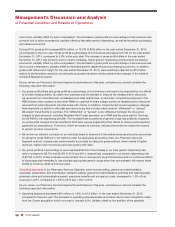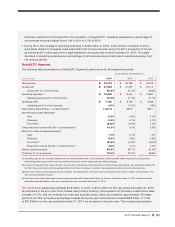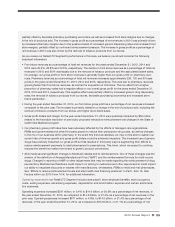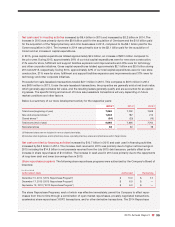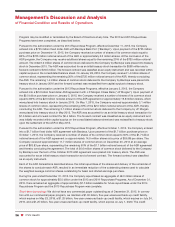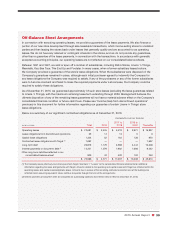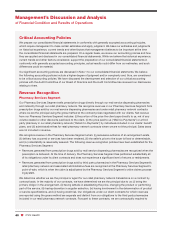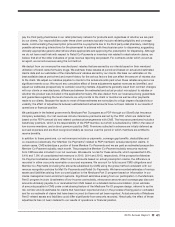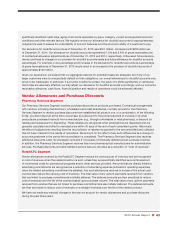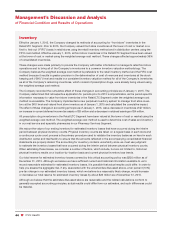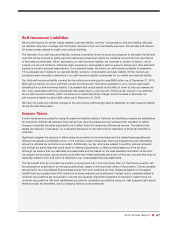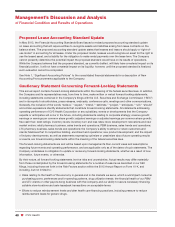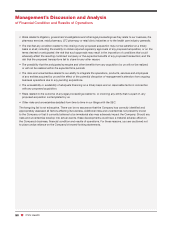CVS 2015 Annual Report Download - page 42
Download and view the complete annual report
Please find page 42 of the 2015 CVS annual report below. You can navigate through the pages in the report by either clicking on the pages listed below, or by using the keyword search tool below to find specific information within the annual report.
Management’s Discussion and Analysis
of Financial Condition and Results of Operations
40 CVS Health
Critical Accounting Policies
We prepare our consolidated financial statements in conformity with generally accepted accounting principles,
which require management to make certain estimates and apply judgment. We base our estimates and judgments
on historical experience, current trends and other factors that management believes to be important at the time
the consolidated financial statements are prepared. On a regular basis, we review our accounting policies and how
they are applied and disclosed in our consolidated financial statements. While we believe the historical experience,
current trends and other factors considered, support the preparation of our consolidated financial statements in
conformity with generally accepted accounting principles, actual results could differ from our estimates, and such
differences could be material.
Our significant accounting policies are discussed in Note 1 to our consolidated financial statements. We believe
the following accounting policies include a higher degree of judgment and/or complexity and, thus, are considered
to be critical accounting policies. We have discussed the development and selection of our critical accounting
policies with the Audit Committee of our Board of Directors and the Audit Committee has reviewed our disclosures
relating to them.
Revenue Recognition
Pharmacy Services Segment
Our Pharmacy Services Segment sells prescription drugs directly through our mail service dispensing pharmacies
and indirectly through our retail pharmacy network. We recognize revenues in our Pharmacy Services Segment from
prescription drugs sold by our mail service dispensing pharmacies and under retail pharmacy network contracts
where we are the principal using the gross method at the contract prices negotiated with our clients. Net revenue
from our Pharmacy Services Segment includes: (i) the portion of the price the client pays directly to us, net of any
volume-related or other discounts paid back to the client, (ii) the price paid to us (“Mail Co-Payments”) or a third
party pharmacy in our retail pharmacy network (“Retail Co-Payments”) by individuals included in our clients’ benefit
plans, and (iii) administrative fees for retail pharmacy network contracts where we are not the principal. Sales taxes
are not included in revenue.
We recognize revenue in the Pharmacy Services Segment when: (i) persuasive evidence of an arrangement exists,
(ii) delivery has occurred or services have been rendered, (iii) the seller’s price to the buyer is fixed or determinable,
and (iv) collectability is reasonably assured. The following revenue recognition policies have been established for the
Pharmacy Services Segment.
• Revenues generated from prescription drugs sold by mail service dispensing pharmacies are recognized when the
prescription is delivered. At the time of delivery, the Pharmacy Services Segment has performed substantially all
of its obligations under its client contracts and does not experience a significant level of returns or reshipments.
• Revenues generated from prescription drugs sold by third party pharmacies in the Pharmacy Services Segment’s
retail pharmacy network and associated administrative fees are recognized at the Pharmacy Services Segment’s
point-of-sale, which is when the claim is adjudicated by the Pharmacy Services Segment’s online claims process-
ing system.
We determine whether we are the principal or agent for our retail pharmacy network transactions on a contract by
contract basis. In the majority of our contracts, we have determined we are the principal due to us: (i) being the
primary obligor in the arrangement, (ii) having latitude in establishing the price, changing the product or performing
part of the service, (iii) having discretion in supplier selection, (iv) having involvement in the determination of product
or service specifications, and (v) having credit risk. Our obligations under our client contracts for which revenues
are reported using the gross method are separate and distinct from our obligations to the third party pharmacies
included in our retail pharmacy network contracts. Pursuant to these contracts, we are contractually required to


